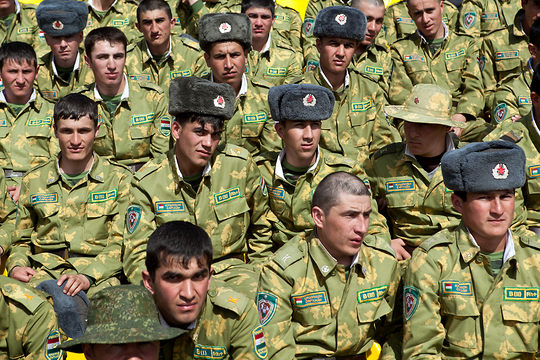
(Photo: David Trilling)
Depending on whom you listen to, Central Asia could be 1) the next mass target of Islamic insurgents; 2) on the verge of a client-state battle between Moscow and Beijing; or 3) fated to authoritarian leaders for the next generation.
Nestled between Russia and China, and bordering Iran, Afghanistan and Pakistan, a glance at the map shows us why any one or all of these are possible.
Porous borders with southern neighbors have long offered insurgent groups unfettered mobility. Kazakh oil and Turkmen gas are irresistible for a growing China, while Russia, lost mother to the region, will not take lightly any marriages outside the family. And patronage politics, whether Soviet or clan legacy, continue apace.
Most residents of the region — Turkmenistan, Uzbekistan, Kazakhstan, Kyrgyzstan and Tajikistan — are descendants of nomadic Turkic tribes, with traditions that evolved from the combination of Mongol hordes and the Persian empire. Little known before the Soviet Union’s demise, these states have had a crash course in geopolitics, through Western concern about radical Islamists, and great powers’ thirst for natural resources.
A handful of scholarly publications and conferences have recently underlined international attention to the region. I profile some of these below.
1) In January 2013, Jeffrey Mankoff of the Center for Strategic and International Studies (CSIS) released his report The United States and Central Asia after 2014.
In this unabashed policy memo, Mankoff characterizes the relationship of the U.S. and Central Asian states and discusses U.S. options after 2014, including the State Department’s much-touted New Silk Road. One of the pillars of his argument is that “stabilizing Central Asia requires connecting to the global economy, which in turn can only be done with Russian and Chinese support.” Most instructional is how each state has its own ideas, from power generation to great power alliance, which fosters suspicion and regional competition, which complicates U.S. policy choices. Any “New Silk Road” linking regional commerce with Pakistan and India, Mankoff argues, depends on Central Asian states’ cooperation, which is lacking. It would also, as written, compete with China, which Mankoff deems unrealistic.
2) In February 2013, International Crisis Group (ICG) released a study, China’s Central Asia Problem.
This 29-page report examines China’s relationship to Russia in the region, economic ambitions, and view of regional security. China’s priority is its western Xinjiang province, where ethnic Uighur groups challenge Beijing’s writ and occasionally join extremists in neighboring states. Drawing on Chinese (and Russian) expert sources, ICG shows how China shares the West’s concerns about political and security unpredictability, especially in Kyrgyzstan and Tajikistan. On the other hand, the China-based Shanghai Cooperation Organization (SCO), which includes Russia and several Central Asian states, has appeared toothless as a mediator. China also risks being an imperialist/expansionist with the influx of its own workers and willingness to fund massive projects without concern for local corruption, the report states.
3) On February 27, 2013, a U.S. House Foreign Affairs Committee (HFAC) hearing, “Islamic Militants in Central Asia.”
Robert Blake, the State Department’s Assistant Secretary, Bureau of South and Central Asian Affairs, and four other regional experts discuss their views of groups that threaten the region, their provenance, and the current governments’ capacities for addressing these threats. Ironically, Chairman Rohrabacher, just back from Uzbekistan, emphasized the risk posed by “hate-filled” Islamic groups, while witnesses warned of authoritarian leaders’ tendency to over-exaggerate insurgent threats as a way to gain Western aid and security materiel (which Ranking Member Keating also pointed out). Bizarrely, Rohrabacher goes on to suggest that the U.S. could sell weapons to Uzbekistan. Aside from the risk of instability in Central Asia from imminent leadership handovers, and some comments on the North Caucasus, generally testimonies did not view militant groups as serious current threats to host governments. [Video and submitted testimonies at the HFAC site.]
4) Released February 18, 2013, “Challenges to Security in Central Asia,” a Russian-language report from the Institute of World Economy and International Relations (IMEMO), Russian Academy of Sciences.
Highlighting views from a November 2012 conference that includes participants from China and Afghanistan, this report showcases Russian and Central Asian experts’ intimate knowledge of the region, with dissections of political movements (e.g., the U.S. courting a pro-Western Islamist Tajik leader, not his party colleague who tends toward Iran) and insight on the tinderbox that is mixed ethnic communities, nationalism, and ambiguous borders. It also details Russian discomfort with U.S. and NATO bases in the region; a representative of IMEMO even charges that the U.S. uses Bishkek as both a transit hub for Afghanistan and a covert listening base. The report concludes with comments on the relationship of the EU and U.S. with each republic, and the role of the Collective Security Treaty Organization (CSTO), a Russian-led institution, as a regional facilitator. So much is made of the advantages of the CSTO, versus its Chinese rival, the Shanghai Cooperation Organization (SCO), one wonders whether the conference itself was a CSTO vehicle. Still, most views — such as those of Arkadii Dubnov, a correspondent for Moscow News, and Muzaffar Olimov, who heads the Sharq Center in Dushanbe — are healthy variants to those on a steady diet of U.S. and European sources.